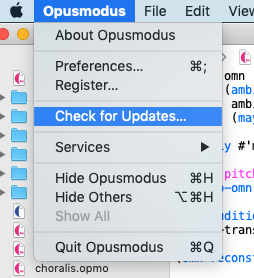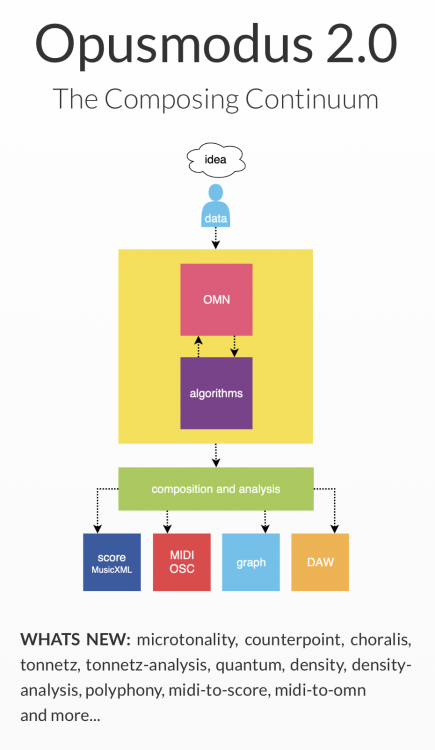-
Posts
2,894 -
Joined
-
Last visited
Content Type
Forums
Events
Store
Video Gallery
Everything posted by opmo
-
The Karajan Music Tech Conference is a cross-industry networking event in a creative environment. Parametric Music Composition with Opusmodus presentation by Stéphane Boussuge
-
The macOS need to be 10.15.4 or higher.
-
To run Opusmodus 2.0 on Catalina you need macOS 10.15.4 or higher.
-
I spent some time making the TONNETZ function a truly compositional tool. I have extended the Tonnetz to 12 spaces (nets) with a possibility of net transitions. Here is how it works. Arguments and Values: chord - a chord or pitch list (intervalic content, one of 12 Tonnetz numbers). transition - list of transition names: p, r, l, n, s, h and 0 (repeat). net - an integer. Tonnetz net label: 1 to 12. join - 0 (a transition) or 1 (a joined transition). step - a list of integers. Number of axis steps: 0 (no change), 1 (1 step up), -1 (1 step down) etc… rotate - a list of integers. Chordal rotation based on a rotate-number value. transpose - a list of integers (transposition value). ambitus - instrument name or an integer or a pitch list (low high). The default is 'piano. Description: The principal transformations of neo-Riemannian triadic theory connect triads (major and minor), and are their own inverses (a second application undoes the first). These transformations are purely harmonic, and do not need any particular voice leading between chords: all instances of motion from a C major to a C minor triad represent the same neo-Riemannian transformation, no matter how the voices are distributed in register. The three transformations move one of the three notes of the triad to produce a different triad: The P transformation exchanges a triad for its Parallel. In a Major Triad move the third down a semitone (C major to C minor), in a Minor Triad move the third up a semitone (C minor to C major). The R transformation exchanges a triad for its Relative. In a Major Triad move the fifth up a tone (C major to A minor), in a Minor Triad move the root down a tone (A minor to C major). The L transformation exchanges a triad for its Leading-Tone Exchange. In a Major Triad the root moves down by a semitone (C major to E minor), in a Minor Triad the fifth moves up by a semitone (E minor to C major). Observe that P preserves the perfect fifth interval (so given say C and G there are only two candidates for the third note: E and Eb), L preserves the minor third interval (given E and G our candidates are C and B) and R preserves the major third interval (given C and E our candidates are G and A). Secondary operations can be constructed by combining these basic operations: The N (or Nebenverwandt) relation exchanges a major triad for its minor subdominant, and a minor triad for its major dominant (C major and F minor). The N transformation can be obtained by applying R, L, and P successively. The S (or Slide) relation exchanges two triads that share a third (C major and Cs minor); it can be obtained by applying L, P, and R successively in that order. The H relation (LPL) exchanges a triad for its hexatonic pole (C major and Ab minor). Any combination of the L, P, and R transformations will act inversely on major and minor triads: for instance, R-then-P transposes C major down a minor third, to A major via A minor, whilst transposing C minor to Eb minor up a minor 3rd via Eb major. Neo-Riemannian transformations can be modelled with several interrelated geometric structures. The Riemannian Tonnetz (‘tonal space’, shown below) is a planar array of pitches along three simplicial axes, corresponding to the three consonant intervals. Major and minor triads are represented by triangles which tile the plane of the Tonnetz. Edge-adjacent triads share two common pitches, and so the principal transformations are expressed as minimal motion of the Tonnetz. One step transformation (basic transformations): P (parallel) R (relative) L (leading) Secondary One step transformation (combine transformations): N (RLP) S (LPR) H (LPL) Two step transformations: Parallel: PR and PL Relative: RL and RP Leading: LR and LP Three step transformations: Parallel: PLR and PRL Relative: RLP and RPL Leading: LPR and LRP Reflection: PLR and RLP are equal. PRL and LRP are equal. RPL and LPR are equal. Basic examples with default Tonnetz 11 (3 4 5). The result of a TONNETZ process is a list of chords or a lists of pitches equal to a length of transition values. (tonnetz '(c4e4g4) '(p p r r l l)) => (c4eb4g4 c4e4g4 c4e4a4 c4e4g4 b3e4g4 c4e4g4) A start list containing pitches will return melodic lists: (tonnetz '(c4 e4 g4) '(p p r r l l)) => ((c4 eb4 g4) (c4 e4 g4) (c4 e4 a4) (c4 e4 g4) (b3 e4 g4) (c4 e4 g4)) (tonnetz '(e4g4b4) '(l r l r p l r l r p)) => (e4g4c5 e4a4c5 f4a4c5 f4a4d5 fs4a4d5 fs4a4cs5 e4a4cs5 e4gs4cs5 e4gs4b4 e4g4b4) (tonnetz '(ab3c4eb4) '(p l p l p l p l)) => (gs3b3eb4 gs3b3e4 g3b3e4 g3c4e4 g3c4eb4 gs3c4eb4 gs3b3eb4 gs3b3e4) (tonnetz '(ab3c4eb4) '(pl pl pl pl)) => (gs3b3e4 g3c4e4 gs3c4eb4 gs3b3e4) (tonnetz '(ab4b4eb5) '(p n l s l n)) => (gs4c5eb5 gs4cs5e5 a4cs5e5 bb4cs5f5 bb4cs5fs5 b4d5fs5) (tonnetz '(c4e4g4) '(plp rpr lpl rpr lpl lpl rprp lpl)) => (b3eb4gs4 a3d4fs4 bb3cs4f4 gs3b3e4 g3c4eb4 gs3b3e4 bb3d4f4 a3cs4fs4) 12 Tonnetz structures In Opusmodus there are 12 Tonnetz structures labelled by a number and by an intervallic content of the composite chord. The intervallic content is a number of semitones associated with the different interval axis. As you will notice each of the intervallic content sum up to 12: 1 (1 1 10) 2 (1 2 9) 3 (1 3 8) 4 (1 4 7) 5 (1 5 6) 6 (2 2 8) 7 (2 3 7) 8 (2 4 6) 9 (2 5 5) 10 (3 3 6) 11 (3 4 5) 12 (4 4 4) In musical tuning and harmony, the Tonnetz (German: tone-network) is a conceptual lattice diagram representing tonal space (net) first described by Leonhard Euler in 1739. Various visual representations of the Tonnetz can be used to show traditional harmonic relationships in European classical music. Examples: With transition value 0 (zero) we define a repeat of the previous transition: (tonnetz '(c4e4g4) '(0 0 l 0 r 0 p 0)) => (c4e4g4 c4e4g4 b3e4g4 b3e4g4 b3d4g4 b3d4g4 bb3d4g4 bb3d4g4) In this example we apply transition successively with the result of the last transition in the sequence: (tonnetz '(c4e4g4) '(0l 0rl 0lr 0pl 0rl 0rl 0lr 0lr)) => (b3e4g4 b3d4fs4 b3e4g4 b3eb4gs4 bb3eb4fs4 bb3cs4f4 bb3eb4fs4 b3eb4gs4) With join value 1 we chordize the successive transition to a chord: (tonnetz '(c4e4g4) '(0l 0rl 0lr 0pl 0rl 0rl 0lr 0lr) :join 1) => (b3c4e4g4 b3d4e4fs4g4 b3d4e4fs4g4 b3eb4e4g4gs4 bb3b3eb4fs4gs4 bb3cs4eb4f4fs4 bb3cs4eb4f4fs4 bb3b3eb4fs4gs4) (tonnetz '(c4e4g4) '(0l 0rl 0lr 0pl 0rl 0rl 0lr 0lr) :join '(1 0 1 0 1 0 1 0)) => (b3c4e4g4 b3d4fs4 b3d4e4fs4g4 b3eb4gs4 bb3b3eb4fs4gs4 bb3cs4f4 bb3cs4eb4f4fs4 b3eb4gs4) transition transposition: (tonnetz '(c4e4g4) '(0l 0rl 0lr 0pl 0rl 0rl 0lr 0lr) :join '(1 0 1 0 1 0 1 0) :transpose '(0 12)) => (b3c4e4g4 b4d5fs5 b3d4e4fs4g4 b4eb5gs5 bb3b3eb4fs4gs4 bb4cs5f5 bb3cs4eb4f4fs4 b4eb5gs5) The step value 1 will move the next transition one step up on the axis of the first interval of the last transition: (tonnetz '(c4e4g4) '(0l 0rl 0lr 0pl 0rl 0rl 0lr 0lr) :join '(1 0 1 0 1 0 1 0) :transpose '(0 12) :step '(1 0 1 0 1 0 1 0)) => (d4eb4g4bb4 d5f5a5 f4gs4bb4c5cs5 f5a5d6 g4gs4c5eb5f5 g5bb5d6 bb4cs5eb5f5fs5 b5eb6gs6) The rotate value is a chordal rotation step number: (tonnetz '(c4e4g4) '(0l 0rl 0lr 0pl 0rl 0rl 0lr 0lr) :join '(1 0 1 0 1 0 1 0) :transpose '(0 12) :step '(1 0 1 0 1 0 1 0) :rotate '(2 0 2 0 2 0 2 0)) => (g4bb4d5eb5 d5f5a5 bb4c5cs5f5gs5 f5a5d6 c5eb5f5g5gs5 g5bb5d6 eb5f5fs5bb5cs6 b5eb6gs6) (tonnetz '(c4e4g4) '(0l 0rl 0lr 0pl 0rl 0rl 0lr 0lr) :net '(11 8 12) :join 1 :transpose '(0 12) :step '(1 0 1 0 1 0 1 0)) => (d4eb4g4bb4 d5e5gs5bb5 fs4bb4d5 f5fs5a5bb5cs6 g4a4cs5eb5 g5b5eb6 bb4cs5eb5f5fs5 bb5c6e6fs6bb6) (tonnetz '(c4e4g4) '(p lrp n h s plrpr n s) :net '(11 8 12) :join 1 :transpose '(0 6 -6) :step '(1 0 1 0 1 0 1 0)) => (eb4fs4bb4 a4b4eb5f5g5 cs4f4a4 fs4g4bb4b4eb5 d5e5fs5bb5c6 e4gs4c5 b4c5eb5e5gs5 fs5gs5bb5c6e6) (tonnetz '(fs4bb4cs5) '(p lrp n h s plrpr n s) :net '(11 8 12) :join 1 :transpose '(0 6 -6) :step '(1 -2 1 -2 1 -2 1 -2)) => (a4c5e5 b4cs5f5g5a5 eb4g4b4 d4eb4fs4g4b4 bb4c5d5fs5gs5 e3gs3c4 b3c4eb4e4gs4 d4e4fs4gs4c5) In the next example we use all 12 Tonnetz with a transition variable (0n). A (0n) transition contains a 0 (repeat) and a n (rlp) successive transition. The alternative writing to (0n) variable is (0rlp). (tonnetz '(c4e4g4) '(0n 0n 0n 0n 0n 0n 0n 0n 0n 0n 0n 0n) :net '(1 2 3 4 5 6 7 8 9 10 11 12) :join 1 :step '(1 0 1 0 1 0 1 0)) => (e3cs4d4eb4 f3fs3g3cs4d4e4 g3gs3c4cs4eb4e4 fs3a3bb3c4cs4f4 bb3b3c4e4f4 f3b3cs4eb4 gs3a3b3cs4eb4fs4 a3b3cs4eb4f4 bb3cs4eb4gs4 bb3cs4e4g4 d4eb4e4fs4g4b4 eb4g4b4) Preview Score examples: In the following example we use Tonnetz 11 with the intervallic content (3 4 5) of minor third, major third and perfect fourth. The join value 1 will join the transition sequence to a chord size 4 and 5. Preview: (setf length '(w h = - q = = = = = w = -q = = = = h = q = = h = -q = = = w -q = = = h = w =)) (setf velocity (gen-prob 64 '((p .4) (mp .6) (mf .2)))) (setf tt1 (tonnetz '(c4e4g4) (rnd-sample 32 '(0l 0rl 0lr) :seed 90198) :join 1 :rotate (rnd-sample 32 '(0 -1 1) :seed 431458))) (setf omn1 (make-omn :length length :pitch tt1 :velocity velocity)) (ps 'gm :pg (list omn1) :time-signature '(4 4) :tempo 88) To examine the intervalic content of three Tonnetz used in the following two examples we run the TONNETZ-STRUCTURE function: (tonnetz-structure '(7 8 12)) => ((2 3 7) (2 4 6) (4 4 4)) Names: (get-interval-name (tonnetz-structure '(7 8 12))) => ((major-second minor-third perfect-fifth) (major-second major-third tritone) (major-third major-third major-third)) Preview: (progn (init-seed 7654) (setf tt2 (tonnetz '(c4eb4g4) (rnd-sample 32 '(0l 0rl 0lr)) :net (rnd-sample 32 '(7 8 12)) :step (rnd-sample 32 '(0 1)) :transpose (rnd-sample 32 '(12 -6 6)))) (setf omn2 (make-omn :length length :pitch tt2 :velocity velocity)) (ps 'gm :pg (list (relative-closest-path omn2 :unique t)) :time-signature '(4 4) :tempo 88) (init-seed nil) ) Tonnetz content: (tonnetz-structure '(1 2 3)) => ((1 1 10) (1 2 9) (1 3 8)) Names: (get-interval-name (tonnetz-structure '(1 2 3))) => ((minor-second minor-second minor-seventh) (minor-second major-second major-sixth) (minor-second minor-third minor-sixth)) Preview: (progn (init-seed 47) (setf tt3 (tonnetz '(c4eb4g4) (rnd-sample 32 '(p l r lr lp rp rl pr pl plr rpl pr lrp lpr pp)) :join 1 :net (rnd-sample 32 '(1 2 3)) :step (rnd-sample 32 '(0 1 2 -2)) :rotate (rnd-sample 32 '(0 1 -1)))) (setf omn3 (make-omn :length length :pitch tt3 :velocity velocity)) (ps 'gm :pg (list (relative-closest-path omn3 :unique t)) :time-signature '(4 4) :tempo 88) (init-seed nil) ) Best wishes, Janusz
-
We have successfully built Opusmodus on macOS 10.15 An update will follow shortly.
-
To update your software to the latest version simply select 'Check for Updates...' from the Opusmodus menu.
-
You need to be able to install developing softwares (compiler) on the iPad and I don't see anytime soon that Apple will change the policy on this. I like the new iPad design too
-
2.0.25669 – Fixes:COUNTERPOINT – span added an additional 1/4 length. PS – error if controller option in an instrument. CREATE-CHORD – error if incorrect chord arguments. ttrem – error in display when ttrem inside a tuplet. Italian documentation – misspels and typos. – Changes: Changes to method names in default Unfold Set OM.lisp file. Update to Quick Start folder. How to install the new Quick Start workspace: 1. Delete the Quick Start folder from your Opusmodus directory. 2. Select the Install Quick Start Workspace command from the Opusmodus Help menu. 3. New Quick Start workspace will open.
-

Trouble setting a second instrument melody
opmo replied to PatrickMimran's topic in Support & Troubleshooting
:layout (list (flute-layout 'flute) (flute-layout 'flute1) Sharing code (score) with others should include custom function if any. -

Keyboard shortcut to restart notation playback?
opmo replied to etu's topic in Support & Troubleshooting
In the menu -

Keyboard shortcut to restart notation playback?
opmo replied to etu's topic in Support & Troubleshooting
control-option-command-1 shortcut will play the last score. -
The function allows you to use the omn-form sequence as well: (attribute-replace '((pizz arco) (arco pizz)) '(q c4 ten+arco e4 pizz f4 arco d4 pizz+marc)) => (q c4 ten+pizz e4 arco f4 pizz d4 arco+marc)
-
The Karajan Music Tech Conference is a cross-industry networking event in a creative environment. Opusmodus 2.0 The Composing Continuum presentation by Stephane Boussuge Karajan Music Tech Conference WWW.KARAJANMUSICTECH.COM Join us for the Karajan Music Tech Conference on April 03, 2020 in Salzburg.
-
Only LEG attribute has a tick overlap.
-
I have extended the functionality of the function: (ambitus-chord '(14 6) '((eb4c6 c4fs4 b4) (c4b4 b3eb5b3))) => ((eb4c5 c4fs4 b4) (c4b3 b3eb4)) (ambitus-chord '(16 6) '((c3g3e4) (c3g3e4))) => ((c3g3e4) (c4g3gs3)) (ambitus-chord '(16 6) '(c3g3e4 c3g3e4)) => (c3g3e4 c4g3gs3) (ambitus-chord '(16 6 6) '((c3g3e4 c3g3e4 c3g3e4) (c3g3e4) (c3g3e4))) => ((c3g3e4 c3g3e4 c3g3e4) (c4g3gs3) (c3g3e4)) (ambitus-chord '(16 6) '(c3g3e4 c3g3e4 c3g3e4 c3g3e4 c3g3e4)) => (c3g3e4 c4g3gs3 c3g3e4 c4g3gs3 c3g3e4) (ambitus-chord '((16 6 11) (6) (6)) '((c3g3e4 c3g3e4 c3g3e4) (c3g3e4) (c3g3e4))) => ((c3g3e4 c4g3gs3 c3g3e3) (c4g3gs3) (c4g3gs3)) Update on its way.
-
Opusmodus microtonal system supports MTS (MIDI Tuning Standard) and Pitch-Bend via Ports. MIDI Tuning Standard (MTS) is a specification of precise musical pitch agreed to by the MIDI Manufacturers Association in the MIDI protocol. MTS allows for both a bulk tuning dump message, giving a tuning for each of 128 notes, and a tuning message for individual notes as they are played. The Virtual Instrument that support MTS: Vienna Instruments, Pianoteq, possibly few more. Sadly 'Native Instruments' is not one of them. An quarter-tone example To use Pitch-Bend instead of MTS would require at least 2 ports. (def-score quarter-tone (:key-signature 'chromatic :tempo '(q 60) :time-signature '(4 4)) (inst1 :omn '(s c4 c4+ c4+ c4+ cs4 cs4+ cs4+ cs4+ d4 d4+ d4+ d4+ eb4 eb4+ eb4+ eb4+ e4) :channel 1 :sound 'gm :program 0 :port '(0 1) ) ) In your DAW you need set 2 ports for each channel (same instrument). An eighth-tone example To use Pitch-Bend instead of MTS would require at least 4 ports. (def-score eighth-tone (:key-signature 'chromatic :tempo '(q 60) :time-signature '(4 4)) (inst1 :omn '(s c4 c4+. c4+ c4+.. cs4 cs4+. cs4+ cs4+.. d4 d4+. d4+ d4+.. eb4 eb4+. eb4+ eb4+.. e4) :channel 1 :sound 'gm :program 0 :port '(0 1 2 3) ) ) In your DAW you need to set 4 ports for each channel (same instrument). MTS example If your instrument support MTS then you use single port, as usual. (def-score eighth-mts (:key-signature 'chromatic :tempo '(q 60) :time-signature '(4 4)) (inst1 :omn '(s c4 c4+. c4+ c4+.. cs4 cs4+. cs4+ cs4+.. d4 d4+. d4+ d4+.. eb4 eb4+. eb4+ eb4+.. e4) :channel 1 :sound 'gm :program 0 :port 0 ) ) The internal GM dose not need any specific setup. Best, Janusz
-
All depends on CCL compiler. Matthew is working on it.
-
(e. g5 lmordent1 s fs 5 e g5 e. a4 s e5 e g5) fs 5 should be fs5 (e. g5 lmordent1 s fs5 e g5 e. a4 s e5 e g5) and you need to add:sound into the instrument instance: (piano-rh :omn piano-righthand :port "Logic" :sound 'gm :channel 1) Good practice with bug like that is to check each bar (list) with a snippet command.
-
(ambitus '(16 26) '(d3e5eb4 gs4)) => (h d6e5a5 gs5) (ambitus '(16 26) '(eb4)) => (a5) (pitch-to-integer '(eb4)) => (3) (pitch-to-integer (pitch-transpose 12 '(eb4))) => (15) (pitch-to-integer (pitch-transpose 24 '(eb4))) => (27) There is no Eb the range between 16 and 26 (integer-to-pitch (gen-integer 16 26)) => (e5 f5 fs5 g5 gs5 a5 bb5 b5 c6 cs6 d6) (integer-to-pitch (rational-ambitus 16 26 3)) => a5 If the range interval is smaller the 12 and the pitch is not part of the range then rational-ambitus function is applied.
-
Where is the problem. Which list.
-
Just received an info: Good news indeed. How this will work with OM build needs to be tested.
-
Catalina 10.15 will be not supported in time of the release of ver. 2.0. CCL is trying to resolve the problem with help of Apple as far as I know. Because of many issues with Apple OS upgrades many people are still on 10.8 - 10.12.
-
Bravo! love it.
- 8 replies
-
- harmonic path
- coltrane
-
(and 2 more)
Tagged with:
-
Same as above with corrections to the renamed function. giant-steps-vl-improv.opmo
- 8 replies
-
- harmonic path
- coltrane
-
(and 2 more)
Tagged with:







